The 10 Best (and One Worst) Day Trips in Argentina
Photos: Argentina Tourist Office Travel Lists ArgentinaFrom Andean volcano peaks to rainforest waterfalls, Argentina has a wealth of natural beauty, and travelers can enjoy many of the best experiences in day trips. The following list highlights the 10 best (and one worst) Argentine adventures that make for memorable days on bikes, boats, feet and 4×4s.
Fitz Roy
Near the village of El Chaltén on the Argentine-Chilean border, Fitz Roy (pictured above) is the mountain whose namesake range appears in the Patagonia clothing logo. Located in Los Glaciares National Park, Fitz Roy has a challenging summit that should be left to experienced climbers, but clearly marked paths allow the average person to enjoy various day hikes. For example, the Laguna Torre hike leads to a lake at the base of the 10,262-foot-tall Cerro Torre, while the strongly recommended (yet more difficult) Laguna de los Tres trek provides one of the best views of Fitz Roy.
Talampaya National Park
Talampaya and Ischigualasto (the latter to follow) are contiguous parks separated by the provincial border of La Rioja and San Juan. Both provinces are associated with winemaking, but these parks have closer ties to a T-Rex than a Torrontés. On the Rioja side, Talampaya claims some of the world’s oldest dinosaur fossils, and prehistoric petroglyphs and paintings provide insight into the desert park’s lost city. Likewise, Instagram addicts will enjoy shooting geomorphic rock shapes with names like the Monk, Chimney and Chessboard as well as sheer 500-foot red-colored walls. Villa Unión is a main departure town for tours, which require a ranger or registered guide.
Ischigualasto National Park (Valley of the Moon)
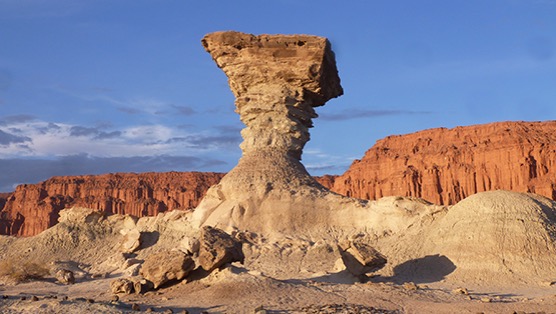
Just north of Talampaya, the lunar landscape of Ischigualasto Provincial Park inspired the alternate name Valley of the Moon, and the heavily eroded terrain would certainly give Buzz Aldrin flashbacks. Though its neighbor also has dinosaur bones, the mother load was found on the Moon Valley side, and the park museum collection includes the Eoraptor, one of the earliest predatory dinosaurs. Ischigualasto also claims a larger collection of geomorphic rock resemblances with names like the Submarine, Worm, Sphinx, Bowling Field and Thor’s Hammer. Those who opt for a full moon tour will be happy to hear none of rocks are called Dracula.
Laguna Brava and Corona del Inca
In the Andes of La Rioja Province, small groups in 4×4 vehicles ascend the rugged trails to the Laguna Brava reserve and Corona del Inca crater set in desolate mountain terrain. At around 10,000 feet, Laguna Brava (Angry Lagoon) is a multi-hued hypersaline lake steeped in Jackson Pollock-style color splatter. Towering volcanic peaks like Pissis (the Andes’ third-tallest at 22,297 feet) overlook the reserve, while out-of-place pink flamingos add a tender touch to an otherwise apocalyptic landscape. During the South American summer, tours can continue to Corona del Inca, a sapphire-blue crater lake near 18,000 feet. By means of contrast, Lake Titicaca (Peru/Bolivia) is called the world’s highest navigable lake at only 12,500 feet.
Quebrada de Humahuaca
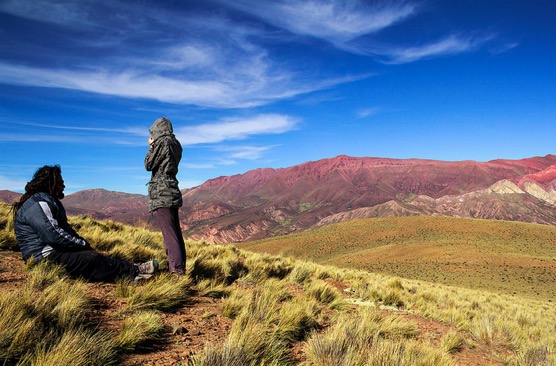
Photo: Flickr/Klaus Balzano
Snaking its way toward Bolivia in the north, the UNESCO-crowned Quebrada de Humahuaca is a mountainous canyon with vast minerals and strata eroded into a parade of vibrant colors. The valley reaches its chromatic peak at three places, i.e., the Painter’s Palette, the Hill of Seven Colors and the Mirador del Hornocal. Though location makes it the least-visited of the bunch, the Mirador is unequalled with more than a dozen rich colors stacked in layers like upside down Vs. Few operators, if any, offer group tours that visit all three locations in a day, so rent a car and visit them independently instead.
Tierra de Fuego
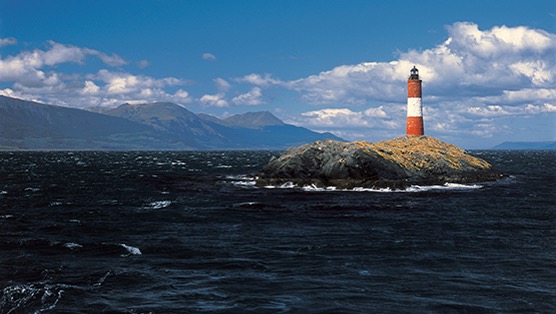
Photo: Argentina Tourist Office
Most people head to Ushuaia for Antarctic cruises, but Argentina’s southernmost tip is also a day-hike paradise with Tierra del Fuego National Park. Separated from the mainland by the Strait of Magellan, Tierra del Fuego (Land of Fire) is an archipelago whose eponymous park is completely contained on the main island. Well-marked trails lead through the Andean-Patagonian forest and up the mountainside to soaring peaks with expansive views. The Pampa Alta trail provides looks across the Beagle Channel, while the forested Hito XXIV stretches around Lago Roca to the Chilean border. From the latter trailhead, a challenging ascent up Cerro Guanaco pays off with viewpoints above 3,000 feet.
Circuito Chico
Bariloche is a taste of Switzerland in South America with fondues, wild game and chocolates that put a stress test on your belt loops. All the more reason travelers should stay active in this gorgeous Lake District town. Cyclists can start with Circuito Chico, a 37-mile loop through lakeside Nahuel Huapi National Park with scenic spots like López Bay, Panoramic Point and the Hidden Lake. Along the way, the luxurious Llao Llao hotel provides an optional water, wine or whiskey stop for cyclists who won’t scare the guests with Lance Armstrong-style spandex. Bus routes can shorten the ride, while side trips and hikes can extend it. Several companies rent bikes for the day.
Iguazú Falls
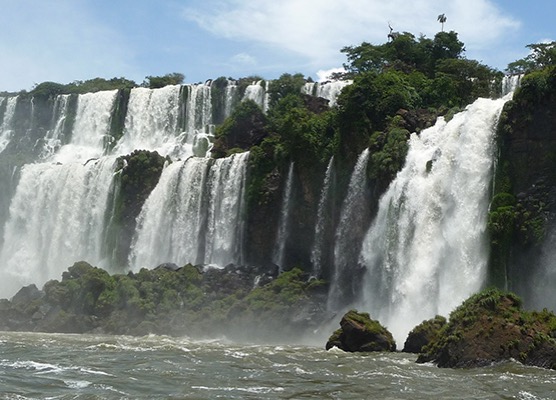
The serpent god M’Boi in the Iguazú River coveted a beautiful girl set to marry an Indian warrior. As per the Guaraní legend, the tribe ceded to the god’s wishes, but before they could perform the river sacrifice, the couple fled in a canoe. The jealous god responded by splitting the earth and collapsing the riverbed into a series of waterfalls. He then turned the warrior into a tree and the girl into a rock so they could see each other but never touch. Love apparently found a way, however, as rainbows occasionally form that appear to connect the rock and tree. Though the more likely origin story involves lava flow, Iguazú Falls is a network of nearly 300 waterfalls in an Amazon-like national park shared by Brazil and Argentina. Brazil has the panoramic vantage points, but the Argentine side provides front-row views with hiking trails and boat rides that go right up to the falls. For any young love pondering a proposal at Iguazú, M’Boi still lurks in the depths near Devil’s Throat, so maybe pick a different spot to pop the question.
El Bolsón
If Bariloche is a Euro-Latin hotspot for tourists, El Bolsón is a nature-centric playground for post-Deadhead bohemians who dig vegan vibes and dopey drum circles. Located about 75 miles south of Bariloche, the no-nukes town drew waves of Buenos Aires hippies in the 1970s, and picturesque nature trails complement its laidback allure. The various trailheads, many of which can be reached on foot, include waterfalls, forests, ridges, swimmable lakes and strange rock formations. Many of the paths are also popular with mountain bikers, who can rent wheels in town.
Perito Moreno Glacier
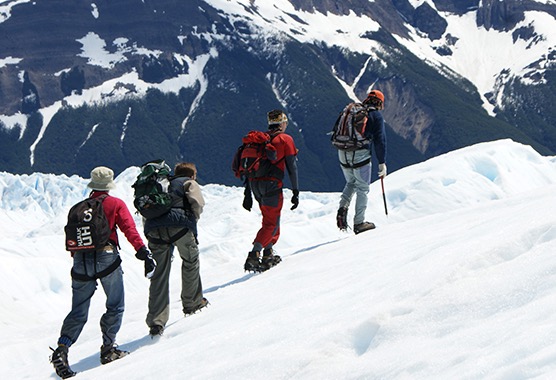
Photo: Argentina Tourist Office
Watching glacial ice sheets crumble into Argentino Lake is certainly one highlight at Los Glaciares National Park, but no visit is complete without trekking across the Perito Moreno Glacier. Multi-hour tours take adventurous travelers across the surface of the 100-square-mile glacier, which reaches about 300 feet in height. To avoid slipping and sliding, tour companies provide spiked crampons that attach to your boots. The terrain includes small water streams, naturally sculpted ice and a bluish glow that emanates from the otherwise stark-white expanse. Pick the right tour operator, and the trek might conclude with a shot of whiskey from a bottle chilled in glacial ice.
The Day Adventure to Avoid: The Train to the Clouds
For all the memorable adventures in Argentina, one trip should be avoided. Tren a las Nubes (Train to the Clouds) in Salta is the nation’s most famous ride, and tickets costing 1,540 pesos each (at 8.91 pesos to the dollar) sell out in advance. The sales pitch itself—a 270-mile journey ascending nearly 14,000 feet into the Andes—sounds like an epic adventure filled with amazing sights. The heavily advertised excursion is, in reality, a cramped 18-hour train ride with limited views save for a stunning 210-foot-high bridge at the peak. On the way back, the train spends about six hours in total darkness while attendants make Herculean attempts to sell merchandise. The train’s Wikitravel entry conspicuously does not allow edits, a move that predates last summer’s derailment at 12,000 feet that required national army help and multi-mile passenger hikes. At the risk of making a grade-school analogy, the Train to the Clouds feels more like the Express Train to Hades.
David Jenison is a Los Angeles native. He has covered entertainment, restaurants and travel for more than 20 years as a writer and editor.